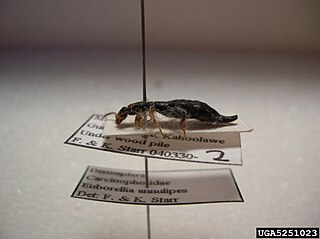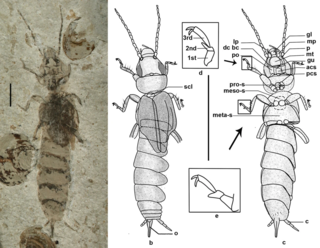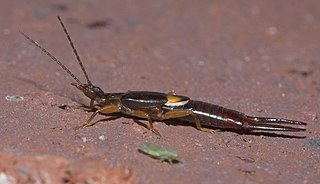
Earwigs make up the insect order Dermaptera. With about 2,000 species in 12 families, they are one of the smaller insect orders. Earwigs have characteristic cerci, a pair of forcep-like pincers on their abdomen, and membranous wings folded underneath short, rarely used forewings, hence the scientific order name, "skin wings". Some groups are tiny parasites on mammals and lack the typical pincers. Earwigs are found on all continents except Antarctica.

Pygidicranidae is a family of earwigs, formerly placed in the suborder Forficulina, now in the suborder Neodermaptera. The family currently contains twelve subfamilies and twenty six genera. Eight of the subfamilies are monotypic, each containing a single genus. Of the subfamilies, both Astreptolabidinae and Burmapygiinae are extinct and known solely from fossils found in Burmese amber. Similarly Archaeosoma, Gallinympha, and Geosoma, which have not been placed into any of the subfamilies, are also known only from fossils. Living members of the family are found in Australia, South Africa, North America, and Asia. The monotypic genus Anataelia, described by Ignacio Bolivar in 1899, is found only on the Canary Islands. As with all members of Neodermaptera, pygidicranids do not have any ocelli. The typical pygidicranid bodyplan includes a small, flattened-looking body, which has a dense covering of bristly hairs (setae). The pair of cerci at the end of the abdomen are symmetrical in structure. The head is broad, with the fourth, fifth and sixth antenna segments (antennomeres) that are not transverse. In general Pygidicranids also have equally sized ventral cervical sclerites, and in having the rearmost sclerite separated from, or only touching the center of the prosternum. Cannibalism of young has been observed in at least one species in the family, Challia hongkongensis, in which an adult female was found eating a still-living nymph of the same species. The same species in a different area has been observed possibly eating fruits or seeds, making the species an omnivore.

Forficulidae is a family of earwigs in the order Dermaptera. There are more than 70 genera and 490 described species in Forficulidae.

Arixeniidae is a family of earwigs in the suborder Neodermaptera. Arixeniidae was formerly considered a suborder, Arixeniina, but was reduced in rank to family and included in the new suborder Neodermaptera.

Hemimeridae is a family of earwigs in the suborder Neodermaptera. Hemimeridae was formerly considered a suborder, Hemimerina, but was reduced in rank to family and included in the new suborder Neodermaptera.

Anisolabididae is a family of earwigs, in the suborder Forficulina and the order Dermaptera. It is one of nine families in the suborder Forficulina, and contains thirty-eight genera spread across thirteen subfamilies.

Diplatyidae is a family of earwigs in the suborder Neodermaptera. It contains three subfamilies, and four genera incertae sedis, one modern and three extinct known from fossils.

Labiduridae, whose members are known commonly as striped earwigs, is a relatively large family of earwigs in the suborder Forficulina.

Labiinae, whose members are commonly known as little earwigs, is a moderately sized subfamily of earwigs in the suborder Forficulina. It is a cosmopolitan family, whose members are small, winged earwigs, generally less than 1.5 centimetres (0.59 in) in length.

Forficulinae is a subfamily of earwigs in the family Forficulidae. There are about 12 genera and more than 160 described species in Forficulinae.
This taxonomy of the Dermaptera follows Engel & Haas (2007) to the rank of Tribe.

Spongiphoridae is a family of little earwigs in the suborder Neodermaptera. There are more than 40 genera and 510 described species in Spongiphoridae.
Allodahliinae is a subfamily of earwigs in the family Forficulidae. There are at least 3 genera and about 16 described species in Allodahliinae.
Ancistrogastrinae is a subfamily of earwigs in the family Forficulidae. There are about 6 genera and more than 30 described species in Ancistrogastrinae.

Anechurinae is a subfamily of earwigs in the family Forficulidae. There are more than 70 described species in Anechurinae.
Neolobophorinae is a subfamily of earwigs in the family Forficulidae. There are about 5 genera and 19 described species in Neolobophorinae.

Opisthocosmiinae is a subfamily of earwigs in the family Forficulidae. There are about 18 genera and more than 100 described species in Opisthocosmiinae.
Skendylinae is a subfamily of earwigs in the family Forficulidae. There are about 12 genera and more than 60 described species in Skendylinae.

Eodermaptera is an extinct suborder of earwigs known from the Middle Jurassic to Mid Cretaceous. Defining characteristics include "tarsi three-segmented, tegmina retain venation, 8th and 9th abdominal tergite in females are narrowed, but separate from 10th tergite and not covered by 7th tergite and exposed ovipositor" They are considered to be more closely related to Neodermaptera than the more basal Archidermaptera.

The Spongiphorinae are a medium-sized subfamily of earwigs in the superfamily Forficuloidea, sometimes called "Little Earwigs", erected by Karl Wilhelm Verhoeff in 1902. Distribution records appear to be incomplete, but genera such as Spongiphora originate from the Americas including the Caribbean; certain species such as Marava arachidis, have a cosmopolitan distribution.
















